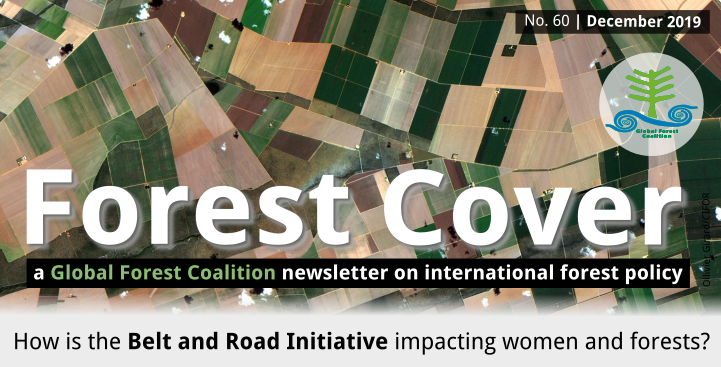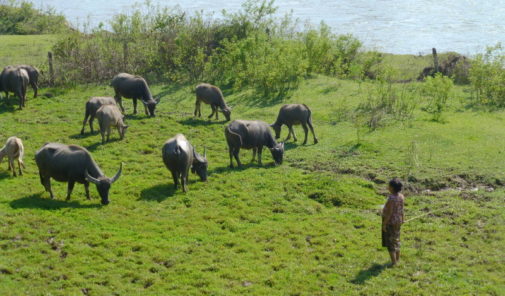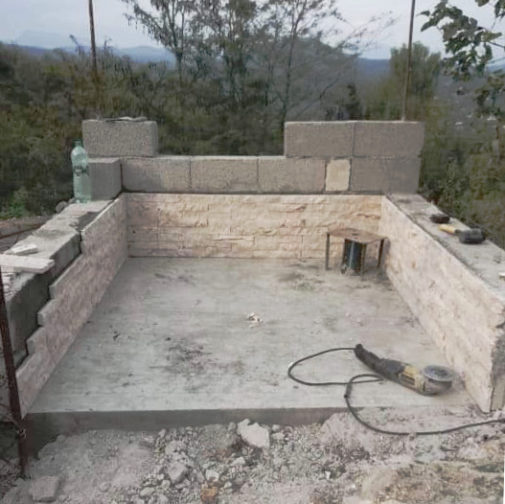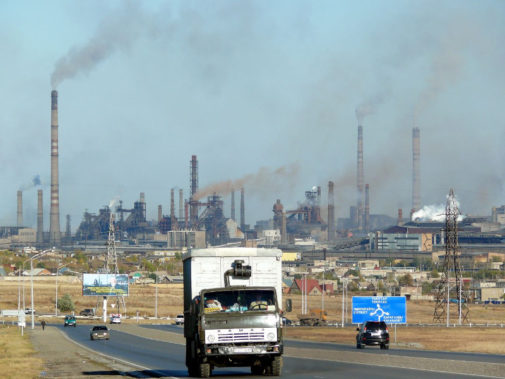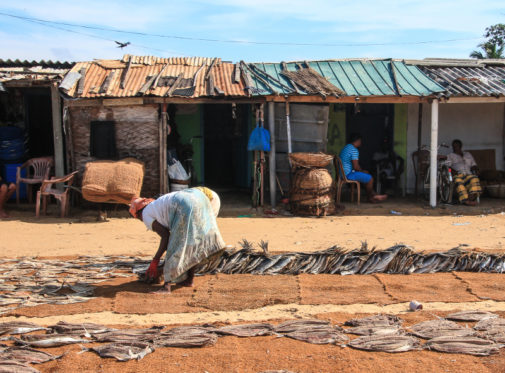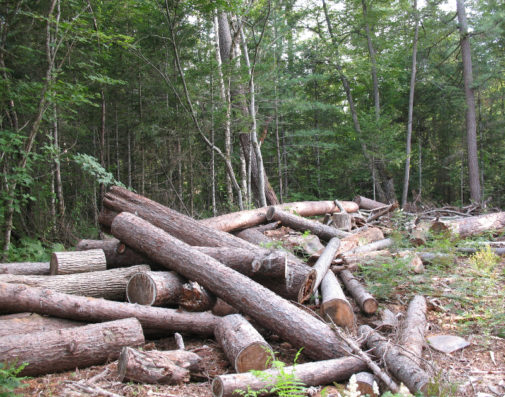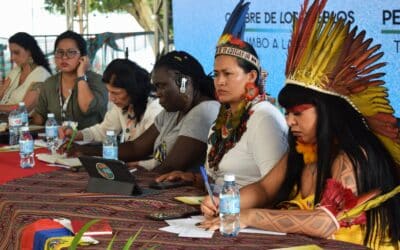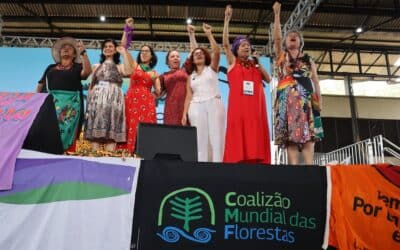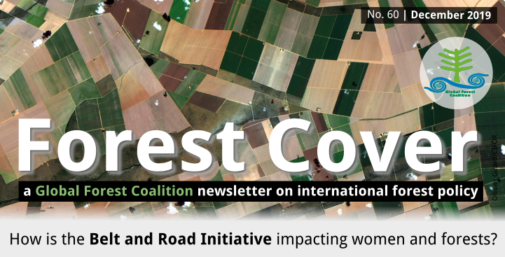
Continuar leyendo en inglés…
Direct investments in infrastructure can cause harm to forests and the Indigenous Peoples, local communities and women that depend on them, and the trade expansion that infrastructure developments facilitate also brings significant impacts. This is especially true where the commodities being traded are drivers of deforestation, most notably palm oil, beef, soy and wood. Infrastructure developments and the expansion of commodity trade also have gender-differentiated impacts, where women experience the consequences of them more acutely, especially when they are members of already-marginalised and vulnerable communities.
In the articles that follow, Global Forest Coalition members analyse the impacts of BRI investments on biodiversity and communities in their own countries, with case studies on Kazakhstan, Kyrgyzstan, Russia and Sri Lanka, and an alternative model of development in Georgia.
You can download the print version or read the articles individually below. You can also subscribe to our mailing list to receive Forest Cover and other publications.
Download the print version in English (web quality 7.5MB | low resolution 0.8MB) and Russian (web quality 7.5MB | low resolution 0.8MB)
Contents:
Editorial: Environmental fuses are needed to protect communities from the Belt and Road Initiative
The «Green» Belt and Road Initiative: business as usual for women and biodiversity
Towards gender equality in Georgia: women’s empowerment and appropriate, gender-responsive infrastructure developments
The Belt and Road Initiative in Kazakhstan: forests and women’s livelihoods under threat?
How is Colombo Port City of China impacting fishing communities in Sri Lanka?
Forests and communities feel the impacts of BRI investments in the Russian Far East and Siberia
Editorial: Environmental fuses are needed to protect communities from the Belt and Road Initiative
By Anna Kirilenko, BIOM and GFC board member, Kyrgyzstan
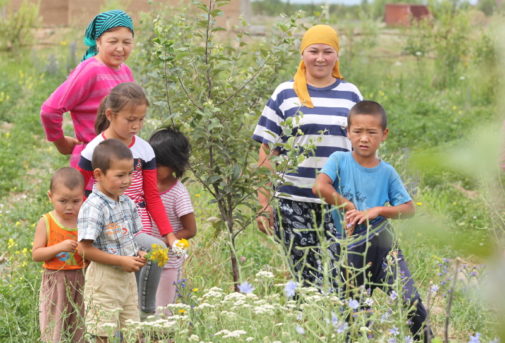
The participation of women’s groups and other civil society organisations in descision-making is key to limiting the impact of BRI projects. BIOM
Today, when economic growth exceeds ecosystem resilience, economic projects are emerging that span many countries and continents.
The risks of environmental degradation and resource over-extraction that international economic projects bring are due to the fact that the place of extraction and the place of consumption are separated from each other. Prior to globalisation, each local community living in a particular territory knew that using natural resources in excess of the ability of forests and other ecosystems to recover would ultimately affect their survival.
This was a factor in limiting the over-exploitation of natural resources and stimulated local communities to introduce various kinds of careful traditional practices such as taboos that governed how natural ecosystems were used. But in the case of international economic projects, this level of regulation and feedback from the consumer does not exist. The consumer largely doesn’t care where the resources they are using have come from, whether it be gold, oil, coal, wood, or any other number of commodities extracted in Central Asia, South America or elsewhere. The consumer does not know what risks local communities and their future generations bear at the point of extraction, and how already marginalised and vulnerable groups, such as women and Indigenous Peoples, disproportionately shoulder these risks. There are no «environmental fuses» or systems of taboos that can stop rampant and ruthless economic growth and global over-consumption.
This edition of Forest Cover focuses on the Belt Road Initiative (BRI). BRI is the Chinese government’s global development strategy to revitalise the old Silk Road, a trans-continental passage that links China with Asia and Europe by land, and a 21st century Maritime Silk Road, a sea route connecting China’s coastal regions to Europe via Asia and Africa. It is expected to involve over US$1 trillion in investments, largely in infrastructure development for ports, roads, railways and airports, as well as power plants and telecommunications networks. The BRI’s geographical scope is constantly expanding and cooperation agreements have been signed with over 120 countries. In the articles that follow, Global Forest Coalition members analyse the impacts of BRI investments on biodiversity and communities, with case studies on Kazakhstan, Russia and Sri Lanka, and an alternative model of development in Georgia.
BRI is in part a response to the fact that China became afraid of the environmental consequences of its own rapid economic growth. In December 2013, China’s former Health Minister Chen Zhu published an article called «China is actively responding to the effects of air pollution on human health», which indicated that every year the number of premature deaths due to air pollution in China ranges from 350,000 to 500,000 people. China has faced a systemic socio-ecological crisis, which translates into extreme environmental pollution, land degradation, depletion of water resources, eco-riots and eco-migration from degraded areas.
In reaction to these environmental problems, the Chinese government is adopting a series of measures and policies aimed at reducing pollution and restoring ecosystems. But the standard being applied in China is very different to the development model being exported to other countries through BRI.
The Chinese government is taking decisive measures to eliminate outdated industries in the country by migrating them beyond China’s borders and into Central Asia and Russia, under the guise of «assistance in economic development». Discussions are ongoing to transfer more than 40 Chinese enterprises to Kyrgyzstan and more than 50 to Kazakhstan. This dubious economic development brings with it very high risks to the environment and public health, and also risks these countries remaining in China’s technological past. The actions of Chinese industries already in Kyrgyzstan are fraught with many social and environmental impacts and show these risks to be a reality.
The construction of the Dzhunda oil refinery in the city of Kara Balta, Chui Oblast, is a good example. There was no consultation with the public and residents have repeatedly protested against its construction and environmental pollution. Many environmental and technical standards were violated in the design and construction of the refinery, and the country’s authorities have followed the lead of large investors by easing environmental requirements and much more. They have also introduced the practice of «parallel design» where Environmental Impact Assessments are not able to assess projects as a whole due to the fact that they take place alongside the design.
Another example is the Altynken mining company, whose main activity is the extraction, processing and production of gold and other non-ferrous metals. De jure: An Environmental Impact Assessment for a mine was submitted to state authorities for examination, comments were received and taken into account, and the conclusions of all examinations and permits were issued in the appropriate manner. De facto: A completely different project to what had been approved was implemented, with the consent of the responsible state authorities. 70% of the 430 workers at the site should have been from Kyrgyzstan, but in fact a large number of illegal workers from China were brought in.
In the implementation of these projects there is often insufficient transparency, a low degree of openness in decision-making processes, and a refusal to involve non-governmental organisations that represent different constituents in civil society such as rural communities and women. Local officials have a high material interest in keeping it this way, and regional and national authorities intentionally reduce or ignore environmental standards to suit whichever project is being implemented.
There are also examples of where women’s groups have been the first to defend the environmental rights of local communities in Kyrgyzstan. A striking example is the case of Panda, a Chinese leather manufacturer that was secretly dumping pollutants into a river in Ivanovka, Chui Oblast. Local activist Anara Dautalieva started a group that conducted an investigation which lead to the closure of the company.
These and many other examples show that we must play close attention to projects falling within BRI’s framework. We need to create networks and other structures of international public solidarity and exchange information and knowledge in order to prevent a recurrence of China’s ongoing environmental tragedy in our own countries. If the high risks that BRI brings are to be mitigated, all opportunities must be taken to integrate environmental fuses into the economic system of the New Silk Road.
The «Green» Belt and Road Initiative: business as usual for women and biodiversity
By Simone Lovera, GFC, Paraguay
China’s Belt and Road Initiative (BRI) was launched in 2013 and is the most ambitious investment scheme in history. By 2018, more than 65 countries were directly involved in it, and between 2014 and 2016 the BRI facilitated US$50 billion in investments and more than US$3 trillion in international trade.
Direct investments in infrastructure like roads and ports can cause harm to forests and the Indigenous Peoples, local communities and women that depend on them. However, it is the associated trade expansion that triggers the most significant impacts, especially if it concerns trade in commodities that are notable drivers of deforestation: palm oil, beef, soy and wood. The expansion of commodity trade also tends to have significant negative impacts on women, as it replaces small-scale, locally-oriented, sustainable production of for example livestock, in which they tend to play a central role, with large-scale, industrial, export-oriented production that tends to be dominated by men. Women in export-oriented agriculture are typically paid less than their male counterparts and aren’t given opportunities to gain technical skills. Where men are the primary earners and women have limited employment opportunities, women can become increasingly economically-dependent on men. As men’s purchasing power increases, so can their decision-making within households.
China is a massive importer of industrially-produced soy and beef. About 80% of all Brazilian soy exports, for example, are destined for China, while soy production is one of the main drivers of deforestation and a key threat to more sustainable, women-led food production. Genuinely transformative change, as prescribed by the UN in “Transforming our world: the 2030 Agenda for Sustainable Development”, implies addressing not only the impacts of infrastructural developments, but also the impacts of the trade model these developments aim to support.
Unavoidably, many existing assessments of the social and environmental impacts of the BRI are ideologically-influenced. The Chinese government tends to highlight how investments in green infrastructure and for example sustainable energy can be a vehicle for green growth and the implementation of the Sustainable Development Goals and the Paris Agreement. US and European agencies and NGOs have put more emphasis on the many negative social and environmental impacts of different BRI projects, and suggested the BRI is a deliberate top-down strategy to secure Chinese dominance in a new world order.
However, there is a lack of comparative analysis of whether BRI investments have actually been more damaging than similar Western investments and, needless to say, concerns that the old US-EU dominated neoliberal world order is changing into a more multipolar system are partly ideologically-driven as well.
Researchers like Wang Hui have highlighted that the Chinese approach to multilateral collaboration is not of a similar imperialist nature as for example the US approach. [1] According to President Xi Jinping himself the BRI is more a “freehand brushwork”, and research points at the many different local, provincial and national Chinese and non-Chinese interests and decision-making processes that steer the BRI, and the challenges the Chinese government faces in ensuring the policy coherence of BRI investments with its own green, low-carbon and sustainable development strategy. [2]
Until recently, the BRI has put quite a lot of responsibility on recipient countries as far as the environmental and social impacts of its investments are concerned. But by facilitating the implementation of large projects, investors carry a significant responsibility for the environmental and social impacts of them, whether they are private, public or state-owned companies. The Chinese government has acknowledged its responsibility, and its Ministry of Ecology and Environment has formally promoted “green development” on the Belt and Road. In 2012 China adopted the Green Credit Guidelines which oblige its banks to comply with relevant national legislation and international norms. But analysis by Friends of the Earth in 2017 concluded that the implementation of these guidelines has been weak, and that there has been a lack of Free Prior and Informed Consent and consultation with local rightsholders in general. [3]
The BRI International Green Development Coalition, which includes Chinese, UN and host country agencies and a number of primarily large US-based NGOs, has been promoting tools like safeguards and Sustainable Asset Valuation to “green” BRI investments. But these initiatives suffer from three major weaknesses. Firstly, they grossly overestimate host country capacity to enforce often voluntary safeguards. Secondly, they do not address more profound governance challenges in the BRI which include a lack of policy coherence as well as a complete lack of equitable participation of social movements representing rightsholders like Indigenous Peoples, women, peasants, workers and affected communities.
The entanglement of public and commercial interests that is triggered by the dominance of state-owned companies and different forms of blended finance in the BRI forms another major governance challenge, as it will provide yet another avenue for the corporate capture of public policy-making, despite China’s claim that it does not embrace such a conventional neoliberal development approach.
Thirdly, and perhaps most profoundly, initiatives to promote safeguards fail to address the impacts of the overall growth and export-oriented development model that the BRI is supporting. Providing some jobs for women in BRI projects does not compensate for the devastating impacts that the replacement of small-scale, sustainable food production with export-oriented agro-industry has on women. Similarly, a few solar panels do not compensate for the devastating forest fires that have been triggered by soy exports to China. The biggest problems with infrastructure developments are not caused by the infrastructure itself, which can sometimes even be welcome for local communities, but by the expansion of agro-industry, extractive industries and mass tourism that tends to accompany these developments.
International trade, whether it is in food, wood or minerals, is a major source of greenhouse gas emissions. In light of the seriousness of the climate crisis, further expansion of international commodity trade is simply incompatible with international climate agreements. We need an urgent divestment from projects that directly or indirectly cause climate change, deforestation and biodiversity loss in general.
The main problem with the BRI is that it promotes the opposite of transformative change. Rather than supporting locally-oriented production and food, wood and energy sovereignty, it locks countries into an export-oriented development model. By definition, this model harms the climate and economically-marginalised groups like Indigenous Peoples, peasant communities and women who are not able to compete with it. For them, seeing their lands and forests destroyed for a “green development” is nothing other than business as usual.
[1] https://www.readingthechinadream.com/wang-hui-the-economy-of-rising-china.html
Towards gender equality in Georgia: women’s empowerment and appropriate, gender-responsive infrastructure developments
By Gizo Urushadze Jr., Dzelkova
A free trade agreement between Georgia and China came into force earlier this year and could pave the way to Georgia becoming a BRI-financed transport and logistics hub between Europe and Asia. This is a worrying sign given how many examples there are of destructive BRI infrastructure developments and other projects, with multiple impacts on communities and ecosystems. But what would appropriate and gender-responsive development look like? This year Global Forest Coalition members the Greens Movement of Georgia (Friends of the Earth Georgia) and Dzelkova carried out three projects in Georgia with small grants from the Women2030 programme that take a completely different approach.
One of the projects, in Tkibuli municipality, aimed to reduce women’s workload and poverty through access to clean water. The main goal of the project was to build a new clean water source in a small village called Motsameta, and to increase knowledge and understanding of the importance of clean water amongst the residents. In spite of the fact that the village is near Kutaisi, one of the biggest cities in Georgia, there is no water supply system. 187 inhabitants had just two wells between them which was not enough. Because of the lack of clean water they were unable to follow elementary norms of hygiene, and this was reflected in the health problems suffered by children and the elderly. Motsameta’s residents did not believe that they were able to overcome this problem by themselves, or that they would receive financial support from outside.
Through the project a new well was built, and the knowledge and participation of people in the community was increased. The new well is providing 20 families (more than 60 people) with clean water, which has helped to improve the lives and reduce the workload of 20 women in the community. In addition, more than 100 people have been trained on the importance of access to clean water.
The other two projects, carried out in Dusheti and Khoni municipalities with Green Regions and the Ecological Farming Association of Georgia (SEMA), aimed to increase women’s participation in decision-making processes at the municipal and regional levels. Seminars, trainings and round-table discussions helped to identify problems, increase knowledge on women’s rights and form plans for how to work together towards gender equality.
The projects identified that a lack of funding was a major barrier to improving work and living conditions for women, and to overcoming other social problems that the communities were experiencing. Participants also described how a lack of hope for a better future prevented women from participating in decision-making processes.
However, the projects helped participants to identify priorities and some little steps were taken in terms of developing partnerships between local government and NGOs on gender issues.
In all of the projects it was clear that there is still a lot of work to do in order to reach gender equality. With large BRI investments potentially on the horizon in Georgia, the projects described above have shown how a focus on gender equality, poverty reduction and women’s participation in decision-making must be at the centre of any new infrastructure developments if they are to have a positive impact on communities.
The Belt and Road Initiative in Kazakhstan: forests and women’s livelihoods under threat?
By Kaisha Atakhanova, Social EcoFund, Kazakhstan
China is the fourth largest investor in Kazakhstan (US$17 billion) and third largest creditor. An agreement to transfer Chinese production into the country was reached in 2014 following a Shanghai Cooperation Organization (SCO) [1] Council of State Leaders meeting in Astana on the BRI and in support of Kazakhstan’s “Nurly Zhol” economic policy (a US$9 billion domestic economic stimulus plan to develop and modernise roads, railways, ports, IT infrastructure, and education and civil services).
According to a list of Kazakhstan-China industrial and investment projects released in 2016 and to be implemented under the intergovernmental agreement, there are 55 projects planned for a total of US$27.5 billion. Since 2014, 15 projects costing US$3.9 billion have been already implemented, 11 projects are being implemented, and 29 projects are currently under review.
It is important to emphasise that information regarding the BRI agreement and its projects was closed to the general public until 2019, and it has only recently become known that BRI projects are being implemented in a wide range sectors of the country’s economy, including mining, oil and gas production, agriculture, transport and logistics, energy generation and the chemical and pharmaceutical industry.
The decision-making and State Expert Review and Monitoring processes for Chinese projects have lacked transparency and openness and have been conducted without considering public opinion. Civil Society Organisations and the wider community have no access to reliable data on State Expert Review results, which include the environmental, social and economic consequences of Chinese projects.
Although gender and family-sensitive policies are actively implemented in Kazakhstan, women’s participation in important environmental decision-making at the national and local levels remains low. This is because in practice government bodies and major businesses often have a formal and declarative attitude towards public policy, restrict public access to important environmental information and neglect the interests of civil society and the community at large. Foreign corporations and investors do not always bring best international «green» practices and environmental standards with them, and ignore the opinions and requirements of environmental activists.
Of particular concern is the protection of Kazakhstan’s remaining forests, which occupy only 3.5% of the country’s area, the majority of which are in East Kazakhstan. Recently, 79% of state forests were transferred into the possession of local authorities (akimats). Unfortunately, the akimats do not fulfill their obligations to preserve and restore forest ecosystems; there are not enough specialists in the field and there is a lack of technical equipment. The government recognises the problem and has threatened to return forests to the National Forestry Committee if local authorities do not urgently change the situation.
The unsustainable use of resources, illegal logging and forest fires all lead to the degradation of Kazakhstan’s forests. For example, a major forest fire in East Kazakhstan in June 2019 affected 40
hectares. [2] There is concern that the long-term impacts of BRI investments coupled with hotter and drier conditions because of climate change will put more pressure on already fragile forests.
Local communities in East Kazakhstan are developing due to income from tourism and their well-being directly depends on the good state of forest and mountain ecosystems. At the same time, women and children in forest communities are the most vulnerable to fires, degradation of local natural resources from logging and the impacts that these have on tourism, due to the loss of sources of income and food in degraded forests.
BRI investments have also caused concern for other reasons. In 2016, the Kazakhstan government initiative to amend the Land Code regulating how land can be leased to foreign citizens gave rise to resentment, public protests and conflicts with authority in the country, caused the loss of confidence in state foreign and internal policy and encouraged sinophobia/anti-Chinese sentiments.
On 4th of September 2019, meetings were held in a number of Kazakhstan’s cities including Nur-Sultan against the 55 BRI projects and the perceived threat that the projects will lead to an influx of Chinese workers. China’s ambassador to Kazakhstan, Zhang Xiao, commented that unspecified «external forces» were provoking a negative attitude in the community towards China and against the development of good relations between the two countries. There has also been conflict between Chinese and Kazakh workers on BRI projects, leading Chinese Consul Geng Liping to say that such conflicts are a threat to Chinese citizens and warned that China could bring its police and paramilitary security forces into the country to protect its own citizens. [3] Given the situation in neighboring Xinjiang province where the Muslim population is experiencing heavy repression and large-scale incarceration in reeducation camps, Kazakhstan nationals see this aspect of Chinese expansion as a serious threat.
It is clear that the implementation of Kazakhstan-China industrial Belt and Road Initiative investment projects is a consequence of a non-transparent, «closed» policy and management system. The government sees and is aware of what is going on but is not standing up for its own country’s interests, and does not adhere to democratic principles in decision-making. This is leading to the growth of social tension in the country and a deterioration of the foreign policy situation with China.
[1] The Shanghai Cooperation Organization is an international organization founded in 2001 by the governments of China, Russia, Kazakhstan, Tajikistan, Kyrgyzstan and Uzbekistan.
[2] https://ru.sputniknews.kz/regions/20180521/5709485/les -pozhar-vostochny-kazakhstan.html
[3] https://ehonews.kz/zayavlenie-konsula-knr-pervyi-zvonok-o-tom-kto-realnyj-hozyain-v-kazahstane
How is Colombo Port City of China impacting fishing communities in Sri Lanka?
By Hemantha Withanage, Centre for Environmental Justice, Sri Lanka
Manoja is a 50-year-old woman with one son and two daughters and lives in Pitipana village. Her husband is a fisherman and she sells the fish he catches at a road-side market. Fishing is their only source of income and her husband earned Rs1500 (around US$8) a day. Before the sand dredging started to fill the ocean to build Colombo Port City, their income was sufficient for their small family. But during the dredging he caught very few fish, not even enough for one meal for their own family.
Pitipana village is located near Sri Lanka’s capital Colombo, and is known for its coastal fishing and fishermen. When the fishermen go out to sea the women and children wait until the boats come to shore with their day’s catch. They then sell the fish at the road-side market. Their life changed when the sand dredging destroyed the coral reefs by spreading fine silt over them, which also destroyed the fishing grounds. They could no longer find reef fish, shrimp or crabs and their catch become very small every day.
The dredging is over but their lives are still in danger. Now, coastal erosion threatens her little home as a result of the waves that the coral reefs used to protect them from, and her back yard has already been washed into the sea. Her family is one of more than 3000 fishing families living along the western coast that are now suffering from the same problems.
Construction of Colombo Port City (also known as Colombo International Financial City) started following a secret agreement signed in 2012 between Sri Lanka’s former president Mahinda Rajapaksha (brother of the newly-elected president, Gotabaya Rajapaksa) and China’s current president Xi Jingping. The 269 hectare land extension was created by filling in the ocean next to the Galle Face Green (an ocean-facing urban park) and will be developed as a financial hub, a business centre and an entertainment location. The project is at the centre of China’s «Maritime Silk Road» and is a globally strategic part of the overall Belt Road Initiative (BRI).
The BRI includes thousands of mini and mega projects implemented by Chinese corporations in different continents. These projects are funded by Chinese banks as well as multilateral banks such as the Asia Infrastructure Investment Bank (AIIB). They have multiple environmental and social impacts and they bring economic problems too. For example, Hambanthota Port was built with a Chinese loan but was sold back to China in July 2017 when Sri Lanka was not able to repay it. Sri Lanka Ports Authority (SLPA) signed an agreement to lease the port to China Merchant Port Holdings for 99 years.
Hambantota Port was also constructed on a wetland once famous for migratory birds such as flamingos, and next to the harbor a 1000ha wildlife sanctuary had its status revoked in order to build other infrastructure related to the harbor. China’s lease agreement also includes control of another 15,000ha of land adjacent to the port designated for an industrial zone. The area includes forests and other important wildlife habitats, and is surrounded by five national parks which are also now in danger. Mattala International Airport is another BRI project that was constructed 18kms away from Hambantota Port. It was built across the Mattala Elephant Corridor, involving the destruction of almost 1000ha of forest and loss of habitat for over 500 elephants.
Colombo Port City is a multibillion project which will be built over the next 35 years and will still be under Chinese control even in the next century. The project has a number of socio-economic and environmental impacts, including the dredging of 65 million cubic meters of sea sand and the massive coastal erosion along the western beach that has been described above. The fishermen that have lost income because of it have not been compensated, but instead the leaders of fisherfolk organisations have been bribed to keep them quiet.
Unless they migrate internally it will not only be Manoja’s children but her grandchildren too who suffer from this Chinese investment. Her family has no money to buy other land. Even if they migrate to another location, Manoja and her husband only know fishing and cannot engage in other livelihoods. The political regime that approved these investments no longer takes responsibility for safeguarding her family. This is the fate of many women and families affected by this BRI investment in Sri Lanka.
Forests and communities feel the impacts of BRI investments in the Russian Far East and Siberia
By Anatoly Lebedev, BROC, Russia
Over the last few years the regional interests and subsistence of Indigenous Peoples in the Russian Far East (RFE) and Siberia have been increasingly ignored by the federal empire. All national and regional governance has concentrated on feeding Chinese industry with natural resources through Belt and Road Initiative (BRI) investments and, therefore, on the large-scale destruction of the last intact and rich natural environments in the region.
Priority investment projects in the RFE Federal District, which was recently expanded to include the Zabaikalsky Krai and Buryat Republic, are being promoted under the Territories of Advanced Development (TAD) and Vladivostok Free Port (VFP) schemes. They demonstrate the continued invasion of Chinese BRI investments into large-scale forestry, agriculture, coal, oil and gas and gold mine enterprises throughout the region. This model of large-scale investment is led by the government and president and aims to destroy the cultural identity and resilience of communities in the region. Labeled as «intense economic development» this strategy tends only to develop the foreign bank accounts of oligarchs, and certainly not local community resilience.
It is also forcing local men to become gold miners and loggers in slave-like conditions with low salaries, and leaves them with limited opportunities for traditional hunting and fishing in the last rivers and intact forests that still survive. Due to the fact that men in indigenous and traditional communities in Siberia spend most of their time away from home, women usually play a more active social, economic and political role than men locally. Women actively participate in community and cultural life, local policy-making, planning and territorial management, and in relationships with officials and schools, all in parallel to managing household needs.
Broadly speaking, BRI investment projects under TAD and VFP demonstrate the positive involvement of city-based women, including in hotel and tourism businesses and in food and agro-processing services. But the bulk of the profits remain concentrated at the municipal level of medium and large cities, and rural communities and families do not benefit from these projects. While men from rural communities keep dying as victims of industrial disasters in the gold mines and in floods and forest fires, and work away from home with migrant workers on the logging sites, women in the communities bring up their children and maintain the great traditional Siberian culture of environmental harmony. For these women, keeping the remaining great intact forests alive is their core livelihood.
If you analyse the resource-based projects that are supported with Chinese investment from the hundreds of projects listed under TAD and VFP, which covers most of Asian Russia, you won’t find many concerned with forests. The reason for this is clear, and was highlighted by a recent federal investigation in Irkutsk Oblast: the biggest logging activities in Siberia are based on «grey» schemes [1] and legal logging leases labeled as «sanitary» or other «maintenance» operations. These used to be highly popular in the southern Far East about 20 years ago, and have now successfully moved into Siberia.
The underlying cause of that shift has been identified by WWF-Amur and other NGOs, including GFC members. We used satellite data to force government agencies to investigate the legality of forest use, and they found many violations involving leases for «sanitary» or «maintenance» operations where Siberian logging companies had successfully used the experiences of their colleagues in the RFE to find a new model of violations. Paid for by Chinese consumers of Siberian raw logs from intact forests, these operations have left Siberian families and women in particular without their only source of subsistence. The Chinese «green BRI» strategy to move environmentally destructive logging and mining practices into the intact forests of Siberia has been disastrous for rural culture and ecosystems in Asian Russia, with millions of hectares of intact forests burned, and rivers killed by corrupt gold mining companies.
There are many more examples of the negative impacts of Chinese investment in the RFE too, such as the scandalous pulp mill project under 100% ownership of Chinese company “Polaris” in Amazar, Zabaikalye Krai. Launched by China more than 17 years ago, the company made absurd claims about available forest resources and underlined the hidden goal of its Chinese partners to build a new bridge over the river Amur between Russia and China. Presented as a means of exporting pulp, the bridge is in practice designed to facilitate the export of raw logs to feed Chinese sawmills and keep them alive. Over the last 20 years hundreds of sawmills and other processing infrastructure have appeared in the Chinese border zone to receive wood from the Siberian taiga, which is now largely gone in many areas, and must now source from further afield.
Despite the hard-fought efforts of the Siberian environmental community to stop these projects, the Russian federal government sees them as a national priority due to the importance of BRI investment. Chinese companies are continuing to exploit the opportunities given to them, and a similar story has occurred with a pulp mill in the Amur river city of Amursk in Khabarovski Krai. After signing a promising agreement with the regional governor at the end of 2018, Chinese investors simply disappeared, leaving the territory with a set of questions on the investments and anticipated tax revenue.
Hundreds of small and large logging and mining businesses are still operating over the vast region and on the traditional lands of indigenous families, supplying timber, gold and coal to Chinese “green BRI” consumers and denying local communities the right to survive. No court or prosecutor is able to protect this constitutional right. The recent disaster involving an illegal gold mine dam in the Krasnoyarsk region demonstrated the cynical level of ignorance that national and regional officials have to human rights and the environment. They are interested in profit at any cost, including human lives.
Under pressure from the «Entire Russia» party and hidden behind the false motto of the «Green Silk Road», legislation dealing with resources focuses not on territorial and social development but on extracting extreme profit from Siberia for Russian and Chinese oligarchs. Our key demand over the last 20 years remains the same: to change governance and legislation in favor of local communities and municipalities as granted by the Russian Constitution, and against the timber and mining oligarchs.
[1] These are logging sites with official documents and permits but that violate their regulations and conditions, such as location of the logging area, harvest volume, restricted species, protected watersheds, wildlife refuges, indigenous territories, etc. Single logging permits are also often used multiple times for different sites.
Editorial Team: Andrey Laletin, Anna Kirilenko, Coraina de la Plaza, Isis Alvarez, Hemantha Withanage, Jeanette Sequeira, Oliver Munnion and Simone Lovera
Editor: Oliver Munnion
Graphic Design: Oliver Munnion
This publication has been produced with the assistance of the European Union and the Swedish Society for Nature Conservation (SSNC). The contents of this publication are the sole responsibility of the Global Forest Coalition and Women2030 Project Partners and can in no way be taken to reflect the views of donors.

